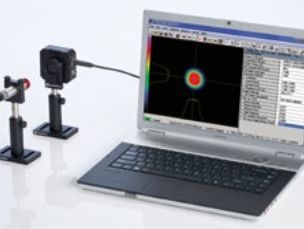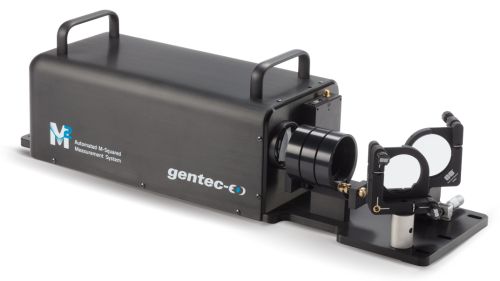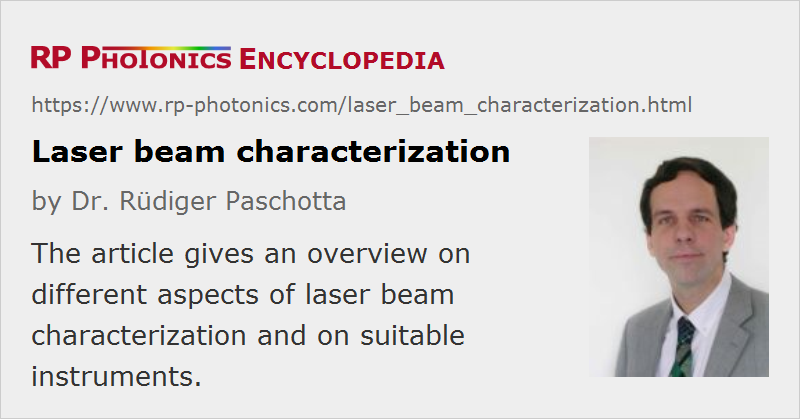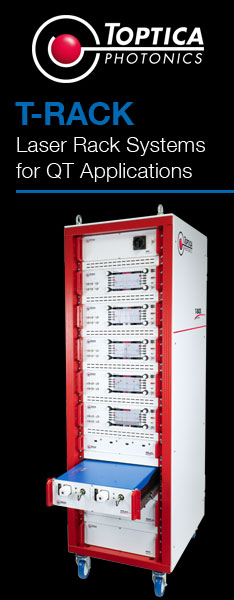Laser Beam Characterization
Definition: methods of assessing detailed properties of laser beams
German: Charakterisierung von Laserstrahlen
Categories: lasers, optical metrology
How to cite the article; suggest additional literature
Author: Dr. Rüdiger Paschotta
Laser beams often need to be comprehensively characterized in various respects. The article gives an overview on different aspects of characterization and on suitable instruments.
Optical Power
For the measurement of the optical power of a laser beam, there are various types of power meters, which may be based on photodiodes or on some kind of thermal detector. For permanent monitoring, there are optical power monitors.
Spatial Aspects: Beam Profiles and Beam Quality
A full characterization of a monochromatic laser beam could in principle lead to the complete complex amplitude profile in one plane perpendicular to the beam, from which the further evolution (propagation) of the beam could be calculated with a suitable beam propagation software, for example. Such a characterization can be done with a Shack–Hartmann wavefront sensor, for example. Although this measures field amplitudes and wavefront directions only on some grid of spots, the amplitudes at intermediate points can be interpolated, if the spatial resolution is good enough. Alternative measurement methods may be based on interferometry, for example.
For non-monochromatic laser beams, one often assumes that the amplitude pattern is not frequency-dependent. That assumption may be completely wrong, however; for example, different resonator modes of a solid-state laser generally have different optical frequencies, so that different frequency components of the generated beam can have entirely different beam profiles. For lasers with operation on a single transverse mode, however, the mentioned assumption can be fairly accurately fulfilled.
There are also various kinds of beam profilers which measure only the intensity distribution, but not the optical phase. They can be based on cameras, for example. A comprehensive assessment of beam quality (quantified e.g. with the beam parameter product or the M2 factor) is nevertheless possible, if such intensity profiles are taken at different positions along the laser beam.
Some laser beams exhibit “hot spots”, i.e., regions with higher intensity, which may play role in damage phenomena. There can also be satellite structures, halos and other deviations from beam uniformity. Note that the shape of the beam intensity profile may change during propagation, and is also not always stable over time.
Some devices do not measure the whole beam profile, but only a beam radius or diameter. Note that the beam radius is usually not defined as a half width at half maximum (HWHM) value, but as the radial position where the intensity falls to 1/e2 times the peak intensity. This comes from the context of Gaussian beams.
A laser beam may exhibit beam pointing fluctuations, which can be measured by monitoring the position (center of gravity of the intensity distribution) at a suitable location.
The polarization state may be roughly characterized based on the power transmission of a polarizer for different orientations, or more completely with various techniques for polarimetry.
Temporal and Spectral Aspects
For pulsed lasers, measurements of the pulse energy, pulse duration and peak power are often required. In case of Q-switched lasers, optical energy meters and fast photodiodes can be suitable. For mode-locked lasers, generating much shorter pulses, one uses instruments like autocorrelators all those for more advanced methods like FROG and SPIDER.
The optical spectrum of a laser beam can be measured with some kind of spectrograph or another kind of spectrometer.
Required Optical Attenuation
For various methods of laser beam characterization, for example with cameras, it is necessary to more or less attenuate a laser beam without e.g. affecting its beam profile. Straight-forward approaches like using some absorbing neutral density filters often do not work at high power levels. Therefore, advanced types of optical attenuators may be needed.
Suppliers
The RP Photonics Buyer's Guide contains 34 suppliers for laser beam characterization instruments. Among them:


Edmund Optics
Laser beam analysers from Edmund Optics include devices such as profiler systems that evaluate data from beam images to provide information such as beam location, peak intensity position, stability, or beam density. For example, there are different kinds of laser beam profilers and autocorrelators for ultrashort pulse characterization.


Gentec Electro-Optics
Gentec Electro-Optics offers a variety of camera-based instruments. This includes compact laser beam profilers and more complex instruments for measuring M2 beam quality factor by automatically analyzing the beam propagation. Besides, we offer optical power meters and various accessories.


DataRay
DataRay offers a full range of ISO 11146-compliant beam profilers, both camera and scanning slit-based.
Camera-based systems include the WinCamD, BladeCam, and TaperCamD series, all of which are USB 2.0 or 3.0 port-powered. These cameras produce a 2D false color digital image of the beam intensity. From these images, XY profiles may be shown for any location on the beam at any angle.
Beam profiling cameras are typically both the optimal and most economical choice when the beam wavelength and diameter are appropriate.
Questions and Comments from Users
Here you can submit questions and comments. As far as they get accepted by the author, they will appear above this paragraph together with the author’s answer. The author will decide on acceptance based on certain criteria. Essentially, the issue must be of sufficiently broad interest.
Please do not enter personal data here; we would otherwise delete it soon. (See also our privacy declaration.) If you wish to receive personal feedback or consultancy from the author, please contact him e.g. via e-mail.
By submitting the information, you give your consent to the potential publication of your inputs on our website according to our rules. (If you later retract your consent, we will delete those inputs.) As your inputs are first reviewed by the author, they may be published with some delay.
See also: laser beams, optical power meters, optical energy meters, beam profilers, Shack–Hartmann wavefront sensors, beam quality, beam pointing fluctuations, spectrographs, spectrometers
and other articles in the categories lasers, optical metrology
 |





If you like this page, please share the link with your friends and colleagues, e.g. via social media:
These sharing buttons are implemented in a privacy-friendly way!